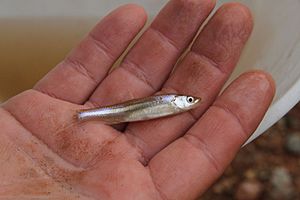Sharpnose shiner facts for kids
The sharpnose shiner (Notropis oxyrhynchus) is a small, shiny fish that lives in rivers. It's part of the carp and minnow family, which includes many types of minnows. This fish is special because it only lives in Texas, USA, specifically in the upper part of the Brazos River. In 2013, it was considered for protection as an endangered species in the United States.
Quick facts for kids Sharpnose shiner |
|
|---|---|
 |
|
| Conservation status | |
| Scientific classification |
Contents
What Does the Sharpnose Shiner Look Like?
This fish is quite thin and usually measures about 3 to 5 centimeters long when it's an adult. That's about the length of your thumb! Some sharpnose shiners can grow up to 9.5 centimeters. It has a shiny silver body. You might see a faint line running from its gills all the way to its tail. Its snout, or nose, is pointed.
Where Does the Sharpnose Shiner Live?
Today, the sharpnose shiner mostly lives in the upper part of the Brazos River system. This is above a large lake called Possum Kingdom Lake. You won't often find this fish below this lake. It might even be gone from most of the smaller rivers that flow into the lower Brazos River.
The fish used to live in the Wichita River too. That river made up almost 70% of where the fish used to be found. But now, the sharpnose shiner is no longer there. Luckily, it is still a common fish in the upper Brazos River.
Sharpnose Shiner's Life and Diet
This freshwater fish likes to live in medium and large rivers. It can be found in river channels and in deeper pools of water. It often lives in shallow, cloudy water. It prefers areas with sand and mud at the bottom.
The sharpnose shiner eats small creatures that live in water or on land. These include different kinds of flies, caddisflies, bugs, beetles, and dragonflies or damselflies. It also eats tiny creatures called ostracods. This fish eats a lot of sand and mud too. This suggests it might be looking for food right on the riverbed. It might also eat some plant material.
Scientists don't know a lot about the full life story of the sharpnose shiner yet.
Protecting the Sharpnose Shiner
Several things have caused the number of sharpnose shiners to go down.
Dams and Reservoirs
Large lakes, called reservoirs, are created by building dams. Water flowing from these reservoirs has changed the river. Things like the water temperature, how fast the water flows, and how cloudy it is have all changed. These changes have broken up the fish's home into smaller pieces.
Lakes like Possum Kingdom, Granbury, and Whitney Reservoirs have changed the types of animals living in the Brazos River. If more reservoirs are built, it could stop the fish from moving back into areas where it used to live.
Invasive Plants
An invasive plant called salt cedar has grown a lot along the Brazos River. The building of reservoirs has helped this plant spread. Salt cedar can make more dirt settle in the river. It also changes how the water flows. This makes parts of the river not good for the sharpnose shiner to live in.
Water Quality Changes
The Brazos River naturally has some salt in its water. This is because of the salty land around it and a salty underground water source. The sharpnose shiner is used to living in this slightly salty water.
However, there is more interest in removing salt from the river water for cities to use. These projects might build wells, pipes, and new reservoirs. These projects, along with water from farms and cities, could change the water and the fish's home.
Other Concerns
Digging for gravel and sand in the river has also affected the lower Brazos River. But we don't know exactly how it impacts the sharpnose shiner. Sometimes, too many tiny plants called algae can grow in the water. This is called an algal bloom. It might also affect the fish, but more research is needed.
See also
 In Spanish: Notropis oxyrhynchus para niños
In Spanish: Notropis oxyrhynchus para niños


